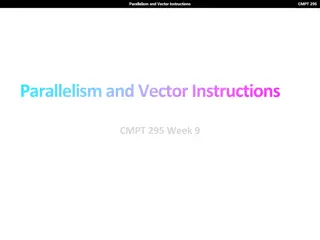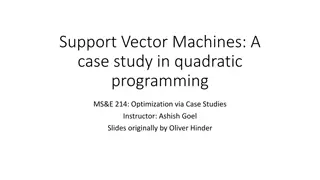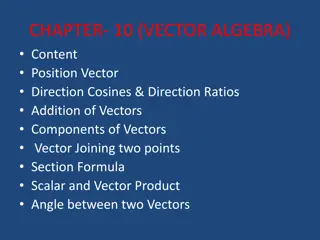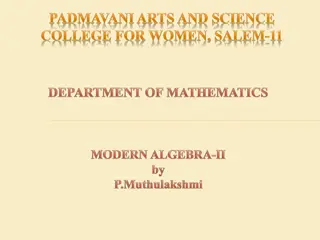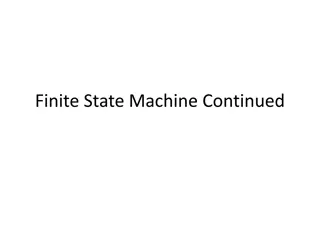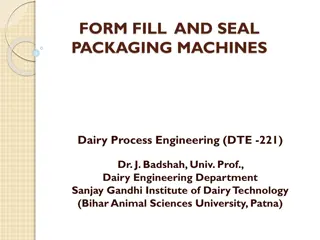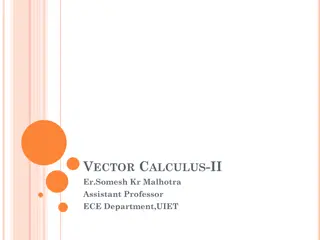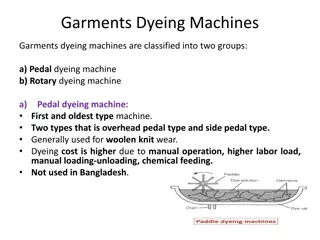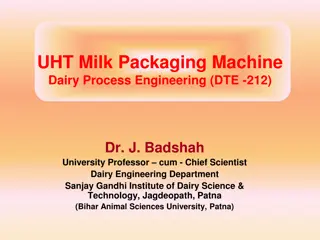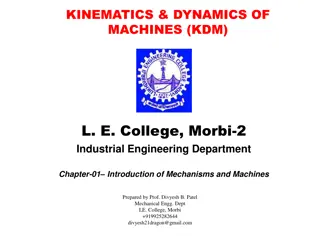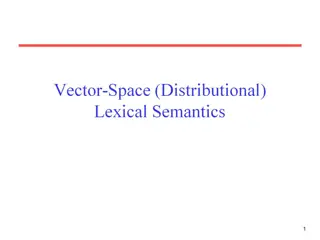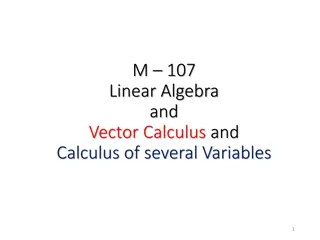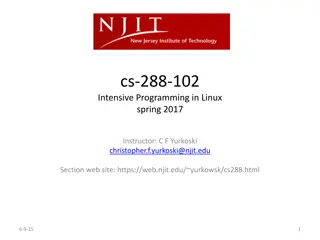Understanding Vector Programming and Machines
Vector programming involves efficient processing of data through SIMD models, parallel computing, and vector extensions in architectures like SSE and AVX. Programming vector machines in C requires addressing challenges with automatic vectorization related to pointers and data layouts.
Download Presentation

Please find below an Image/Link to download the presentation.
The content on the website is provided AS IS for your information and personal use only. It may not be sold, licensed, or shared on other websites without obtaining consent from the author. Download presentation by click this link. If you encounter any issues during the download, it is possible that the publisher has removed the file from their server.
E N D
Presentation Transcript
Vector Programming David Gregg Trinity College Dublin 1
Vector Parallel Computing Vector computers One of the most powerful type of early supercomputers SIMD model One instruction performs the same operations on a whole bunch of data Mathematicians call a 1D array a vector Vector instructions operate on 1D array Usually a short subsequence at a time Operations on 2D arrays built from 1D primitives 2
Vector Extensions Many processor designers have added a vector unit to their existing processors Intel Multimedia Extensions (MMX) Streaming SIMD Extensions (SSE) Advanced Vector Extensions (AVX) 256 and 512 bit variants ARM NEON, SVE RISC V V 3
Vector Architectures Vector architectures are a type of SIMD Registers contain a short array of values Intel SSE: 128 bits, four FP32 numbers Intel AVX: 256 bits, eight FP32 numbers Intel AVX512: 512 bits, 16 FP32 numbers Vector machine instructions operate on all lanes of a vector instruction 4
SSE We are going to look at SSE It s quite old but It s supported on our lab machine It s very similar to more recent, wider Intel vector instruction sets Streaming SIMD extension (SSE) It s just a brand name that s supposed to sound high-tech Flux capacitor Millennium Falcon Pan galactic gargle blaster It s a plain old short vector architecture 5
Programming Vector Machines There are several ways to program a vector machine Program in plain C And hope that a heroic compiler will vectorize the code Production compilers are getting better Intel compiler is good GCC is okay LLVM is not good but improving quickly 6
Programming Vector Machines in C Two big problems for compiler automatic vectorization Pointers Data layouts 7
Programming Vector Machines in C Pointers void sum(float *a, float * b, float *c) { for ( int i = 0; i < N; i++ ) a[i] = b[i] + c[i]; } In general the compiler has no idea whether pointers a, b, c point to the same memory Restrict pointers guarantee not to point to same memory as another restrict pointer void sum(float * restrict a, float * restrict b, float * restrict c); 8
Programming Vector Machines in C Data layout is often crucial to the vectorization of code struct point { float x, y, z; }; struct point my_points[1024]; As compared to struct points { float x[1024], y[1024], z[1024]; }; 9
Other Approaches to Programming Vector Machines Program in a domain-specific language Aimed at vector types Often obscure languages Mom and pop languages Maintenance, legacy problems More recently mainstream languages are starting to add vector features E.g. vector types in C source code using Clang/LLVM parallel SIMD in OpenMP 10
Other Approaches to Programming Vector Machines Assembly Gives complete control over the machine Can pick exactly the right vector instructions Tedious, error prone, hard to maintain Compiler intrinsics Functions that are built into compiler Vector machine instructions are expressed as C function calls Middle ground between assembly and pure C 11
Compiler Intrinsics We will do vector programming using compiler intrinsics It s sort of low-level, but we want to understand the architectures 12
Vector Load Instructions __m128 _mm_load_ps(float * src); Load 4 floats from a 16-byte aligned address __m128 _mm_loadu_ps(float * src); Load 4 floats from a (possibly) unaligned address; slightly slower than aligned instruction __m128 _mm_load1_ps(float * src); Load one float into all four lanes of a vector __m128 _mm_setr_ps(float a, float b, float c, float d); Insert four values into four lanes of a vector __m128 _mm_set1_ps(float a); Insert a single value into all four lanes of a vector 13
Vector Store Instructions void _mm_store_ps(float * dest __m128 value); Store a vector of floats to a 16-byte aligned address Segmentation fault if the address is not aligned void _mm_storeu_ps(float * dest, __m128 value); Store a vector of floats to a 16-byte unaligned address void _mm_store_ss(float * dest __m128 value); Store the float value in lane zero to memory There also exists: __m128 _mm_load_ss(float * src) Load a single float to lane zero of the destination vector; set other lanes to zero 14
Alignment All data types have a size in bytes 4 byte int, 8 byte double, etc. A variable is said to be aligned if 15
Arithmetic Instructions __m128 _mm_add_ps(__m128 a, __m128 b); Add corresponding lanes of a and b, and return a vector result __m128 _mm_sub_ps(__m128 a, __m128 b); Subtract corresponding lanes of a and b, and return a vector result __m128 _mm_mul_ps(__m128 a, __m128 b); Multiply corresponding lanes of a and b, and return a vector result __m128 _mm_div_ps(__m128 a, __m128 b); Divide corresponding lanes of a and b, and return a vector result __m128 _mm_sqrt_ps(__m128 a); Return a vector containing the square root of each value 16
Example void sum(float * a, float * b, float * c) { for ( int i = 0; i < 1024; i++ ) { a[i] = b[i] + c[i]; } } 17
Example void sum(float * restrict a, float * restrict b, float * restrict c) { for ( int i = 0; i < 1024; i++ ) { a[i] = b[i] + c[i]; } } This might be vectorized as: void sum(float * a, float * b, float * c) { for ( int i = 0; i < 1024; i = i+ 4 ) { __m128 b4 = _mm_loadu_ps(&b[i]); __m128 c4 = _mm_loadu_ps(&c[i]); __m128 a4 = _mm_add_ps(b4, c4); _mm_storeu_ps(&a[i], a4); } } 18
Example void sum(float * a, float * b, float * c, int size) { for ( int i = 0; i < size; i++ ) { a[i] = b[i] + c[i]; } } 19
Example void sum(float * a, float * b, float * c, int size) { for ( int i = 0; i < size; i++ ) { a[i] = b[i+1] + c[i]; } } 20
Example void sum(float * a, float * b, int size) { for ( int i = 1; i < size; i++ ) { a[i] = a[i-1] + b[i]; } } 21
Example void sum(float * a, int size) { for ( int i = 1; i < size; i++ ) { a[i] = a[i-1]; } } 22
Example void sum(float * a, float * b, int size) { for ( int i = 4; i < size; i++ ) { a[i] = a[i-4] + b[i]; } } 23
Operating Across Lanes The examples we have seen so far have all involved arithmetic on values of The same lane But Different vectors Sometimes you want to be able to mix values from different lanes Simplest (but slow) solution is to store a vector to a temporary array: float temp[4]; _mm_store_ps(temp, my_vector); 24
Example float mean(float * a, int size) { float sum = 0.0; for ( int i = 0; i < size; i++ ) { sum = sum + a[i]; } return sum/(float)size; } 25
Operating Across Lanes There is also a very small number of arithmetic instructions that operate across lanes By far the most important is: _m128 _mm_hadd_ps(_m128 a, _m128 b); Takes operand a: [a3, a2, a1, a0] Operand b: [b3, b2, b1, b0] Returns: [a3+a2, a1+a0, b3+b2, b1+b0] 26
Operating Across Lanes There is also a very small number of arithmetic instructions that operate across lanes By far the most important is: _m128 _mm_hadd_ps(_m128 a, _m128 b); Takes operand a: [a3, a2, a1, a0] Operand b: [b3, b2, b1, b0] Returns: [a3+a2, a1+a0, b3+b2, b1+b0] 27
Example float mean(float * a, int size) { float sum = 0.0; for ( int i = 0; i < size; i++ ) { sum = sum + a[i]; } return sum/(float)size; } 28
Operating Across Lanes Vector swizzles can also operate across lanes Permute: re-orders lanes within a vector Note that when we talk about permute we typically allow an element to be repeated or omitted This is different from a permutation in the mathematical sense of a reordering of the same elements Blend: Select corresponding lanes from two vectors Shuffle: A combination of permutes and blends 29
Vector Swizzles There are *lots* of swizzle operations in most vector instruction sets Lots of restrictions and special cases This may seem odd It s much easier for programmers and compiler- writers to use a small number of general instructions For example we might like: An arbitrary permute operation Permute(|a,b,c,d|) -> any permutation, e.g. |b,d,c,a| But the hardware cost of completely arbitrary permute operations can be high 30
Vector Swizzling We will primarily use _m128 _mm_shuffle_ps(a, b, _MM_SHUFFLE(1, 0, 3, 2); Two input vectors: |a3, a2, a1, a0| |b3, b2, b1, b0| Creates output vector based on _MM_SHUFFLE Selects first two lanes of result from a, second two lanes from b In this example parameters are (1, 0, 3, 2) Output: |a1, a0, b3, b2| 32
Example Hadd with shuffles Create a sequence of vector instructions that replicates the behaviour of the _mm_hadd_ps instruction result = _mm_hadd_ps(a, b); Inputs: |a3, a2, a1, a0|, |b3, b2, b1, b0| Outputs|a3+a2, a1+a0, b3+b2, b1+b0| 33
Example Hadd with shuffles Output:|a3+a2, a1+a0, b3+b2, b1+b0| To compute this we will need the vectors |a3, a1, b3, b1| and |a2, a0, b2, b0| _m128 a3a1b3b1 = _mm_shuffle_ps(a, b, _MM_SHUFFLE(3, 1, 3, 1)); _m128 a2a0b2b0 = _mm_shuffle_ps(a, b, _MM_SHIFFLE(2, 0, 2, 0)); _m128 result = _mm_add_ps(a3a1b3b1, a2a0b2b0); 34
Example Complex Multiplication struct complex { float r; float i; }; struct complex a[1024], b[1024], c[1024]; for ( int j = 0; j < 1024; j++ ) { a.r = (b.r * c.r) (b.i * c.i); a.i = (b.r * c.i) + (b.i * c.r); } // real // imaginary 35
Accessing Individual Lanes Most vector instruction sets have some mechanism to insert/extract a value to/from an individual lane within a vector E.g. in Intel SSE __m128i _mm_insert_epi32(__m128i a, int b, const int lane_no); Returns a vector that consists of the original vector a, but with lane number lane_no overwritten with the value of b. 36
Accessing Individual Lanes Also in Intel SSE int _mm_extract_epi32(__m128i a, const int lane_no); Returns the integer stored in lane lane_no Strangely, there is no equivalent instruction in SSE for floating point numbers In other words you can move a value from the vector registers to the general-purpose registers You cannot move a value from the vector registers to a floating-point register 37
Accessing Individual Lanes In practice the lack of floating point insert/extract instructions means that loading/storing directly to a lane is more awkward than it should be: _m128 r = (m128) _mm_insert_epi32((_m128i) a, *((int*)ptr), LANE_NUM); *((int*)p) = _mm_extract_epi32((_m128)a, LANE_NUM); 38
Accessing Individual Lanes In practice the lack of floating point insert/extract instructions means that loading/storing directly to a lane is much more awkward than it should be One possible solution: _m128 r = (m128) _mm_insert_epi32((_m128i) a, *((int*)ptr), LANE_NUM); *((int*)p) = _mm_extract_epi32((_m128)a, LANE_NUM); 39
Accessing Individual Lanes One possible solution: _m128 r = (m128) _mm_insert_epi32((_m128i) a, *((int*)ptr), LANE_NUM); *((int*)p) = _mm_extract_epi32((_m128)a, LANE_NUM); This code is actually quite risky C strict aliasing rules Compiler assumes that pointers of different types cannot point to the same memory Much safer to use C unions for conversions 40
Bitwise Operations Like most vector instruction sets, SSE provides a variety of bitwise instructions __m128 _mm_and_ps(__m128 a, __m128 b) __m128 _mm_or_ps(__m128 a, __m128 b) __m128 _mm_andnot_ps(__m128 a, __m128 b) __m128 _mm_xor_ps(__m128 a, __m128 b) Bitwise vector operations allow lots of bitwise parallelism E.g. union/intersection of bit vector sets 43
Comparison Operators We can compare corresponding lanes of pairs of vectors __m128 _mm_cmpeq_ps(__m128 a, __m128 b); __m128 _mm_cmplt_ps(__m128 a, __m128 b); __m128 _mm_cmple_ps(__m128 a, __m128 b); __m128 _mm_cmpgt_ps(__m128 a, __m128 b); __m128 _mm_cmpge_ps(__m128 a, __m128 b); __m128 _mm_cmpneq_ps(__m128 a, __m128 b); __m128 _mm_cmpnlt_ps(__m128 a, __m128 b); __m128 _mm_cmpnle_ps(__m128 a, __m128 b); __m128 _mm_cmpngt_ps(__m128 a, __m128 b); __m128 _mm_cmpnge_ps(__m128 a, __m128 b); // = // < // <= // > // >= // != // !< // !<= // !> // !>= 44
Comparison Operators The result of a comparison operation is always a mask with values: Integer 0 in false lanes Integer -1 in true lanes __m128 a = _mm_set_ps(0.0f, 1.0f, 2.0f, 3.0f); __m128 b = _mm_set_ps(3.0f, 2.0f, 1.0f, 0.0f); __m128 mask = _mm_cmpgt_ps(a, b); // mask now has value [0, 0, -1, -1] 45
Comparisons and masking 0/-1 masks can be used with bitwise ops Integer zero is 0000000000000 Integer -1 is 1111111111111 These can be used to mask out values for ( i = 0; i < 1024; i++ ) { if ( a[i] < b[i] ) { a[i] = 0.0; } } 46
Comparisons and masking Masking can be used to vectorize many loops containing if statements First compute both sides of the if statement Then select the correct result for each lane using masks E.g. for ( i = 0; i < 1024; i++ ) { if ( a[i] > b[i] ) c[i] = a[i]; else c[i] = b[i]; } 47
Comparisons and masking SSE also allows us to convert a full-width vector mask to a bit-by-bit integer mask int _mm_movemask_ps(mask); Takes a mask of 0/-1 lanes and converts each lane to a single bit of a result integer For example Bitmask Meaning 1111 Comparison True for all 4 floats 0000 Comparison False for all 4 floats 1100 Comparison True for first two floats 1010 Comparison True for first and third floats 48
Comparisons and masking The movemask converts a vector mask to an integer Integer can be stored to summarize comparison Integer can be tested with if or switch statement For example _m128 vec_mask = _mm_gt_ps(a, b); int mask = _mm_movemask_ps(vec_mask); switch ( mask ) { case 0: // all false . 49
Comparisons and masking Vectorize the following code float min = a[0]; for (i=1; i < 1024; i++ ) { if ( a[i] < min ) { min = a[i]; } } 50
Max and Min Finding the minimum or maximum of pairs of numbers is so common that most vector instruction sets provide instructions _m128 _mm_max_ps(_m128 a, _m128 b); _m128 _mm_min_ps(_m128 a, _m128 b); 51
When can we vectorize? We normally vectorize loops It s possible to use vector operations outside loops But loops are the most common use We normally vectorize array code A vector is a one-dimensional array Vector machines are aimed at array code 52
When can we vectorize? A key factor is data dependencies between iterations of the loop for ( int i = 1; i < size; i++ ) a[i] = a[i-1] * b[i] To compute a[i], we must already know the value of a[i-1] Thus, we must compute a[i-1] before we compute a[i] Thus, we cannot compute a[i] and a[i-1] at the same time Thus, we cannot vectorize this loop in its current form And we probably can t vectorize this loop at all 53




